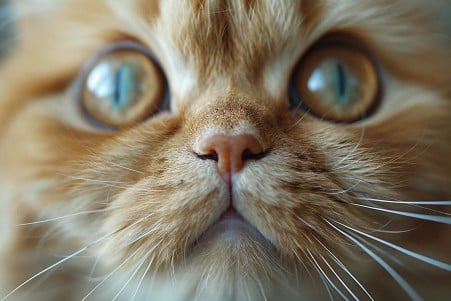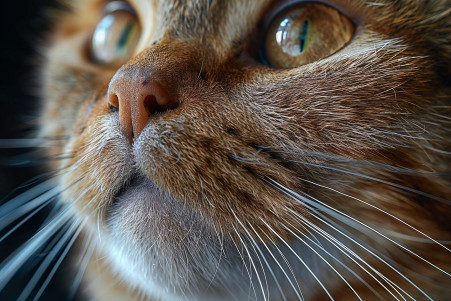Whisker Shedding and Regrowth in Cats: What the Research Says
22 April 2024 • Updated 22 April 2024

If you’ve ever watched your cat groom itself, you’ve probably seen a whisker or two fall out. But do cats shed and regrow their whiskers? The answer is yes. Cats shed and regrow their whiskers, or vibrissae, on a regular basis. Vibrissae are long, stiff hairs that help cats navigate their environment, and they are shed and replaced in the same way as other hairs on a cat’s body. So, shedding a few whiskers at a time is completely normal.
To learn more about this process and why it happens, let’s take a look at some of the biological research that has been done on the growth and function of feline vibrissae. This research will help explain why cats shed their whiskers, how often it happens, and what it might mean if a cat sheds its whiskers more than usual in terms of their overall health. It will also give you a better understanding of this interesting part of cat anatomy and behavior.
Do cats shed their whiskers?
Whiskers Help Cats Navigate Their Surroundings
Whiskers, or vibrissae, are highly sensitive sensory organs that serve several important purposes for cats. These long, stiff hairs help cats with their vision, particularly up close and in dim lighting, by detecting changes in the air and vibrations. As cats move closer to objects, their whiskers can detect minute changes in the air, essentially acting as radar detectors that help cats move through their environment without running into things.
In addition, whiskers assist cats in determining the size of openings and spaces, which helps them figure out if they can fit through tight spaces. Because cats have whiskers positioned about as wide as their body, they can tell if a space is too narrow before they try to squeeze through it. Whiskers even help cats hunt by transmitting vibrations that may indicate the presence of prey.
In addition to helping cats navigate and hunt, whiskers are important for a cat's overall sensory perception and communication. The position and movement of whiskers can signal a cat's emotional state, such as moving forward to indicate that a cat feels threatened. Whiskers aren't just located on a cat's muzzle, either. They can also be found above a cat's eyes, on their cheeks, and even on their front legs, with about 24 whiskers on each side of a cat's face that are distributed symmetrically. This means that whiskers are well-positioned to detect changes in a cat's environment from a variety of angles.
The Natural Whisker Shedding and Regrowth Cycle
Whiskers are shed and regrown as part of a cat's natural growth cycle, just like the rest of their hair. Per Cats.com, individual whiskers are typically shed and regrown every few months, and the process happens gradually. The TinRoof Cats blog notes that it can take between 4 weeks and 3 months for a cat to regrow a full set of whiskers, and the length of time depends on the cat's age, health, and other factors.
Losing a few whiskers at a time is normal and healthy because it makes room for new, strong whiskers to grow in their place. However, per the Biology Stack Exchange, if a cat loses a lot of whiskers all at once, it may be a sign of an underlying problem that needs to be addressed by a vet.
Causes of Excessive or Abnormal Whisker Loss
While some whisker loss is normal, excessive or sudden loss could be a sign of an underlying health issue. Canidae lists potential causes of abnormal whisker loss as allergies, skin infections, physical trauma or injury, feline acne, and stress or anxiety.
Catster notes that medical conditions like nutritional deficiencies, autoimmune disorders, or endocrine imbalances can lead to excessive shedding. Environmental causes, such as exposure to irritants or changes in diet or living conditions, may also cause some cats to lose their whiskers abnormally.
If you see a lot of whisker loss, bald patches around the whisker area, or other physical or behavioral changes, it's important to see a Lincolnway Veterinary Clinic veterinarian for a proper diagnosis and treatment. Finding and treating the cause is the only way to get your cat's whiskers back to normal.
Consequences of Whisker Loss and Proper Whisker Care
The loss of a cat's whiskers can have a number of consequences for their ability to move and sense their surroundings. According to Wagwalking.com, whiskers are highly sensitive sensory organs that enable cats to detect the most subtle changes in the air. Without their whiskers, cats may have difficulty judging distances, getting through small spaces, and finding their food bowls, especially in the dark.
Whisker loss can also result in disorientation, increased stress and anxiety, and a greater likelihood of injury or accidents, as cats use their whiskers to maintain their balance and sense of space. As pointed out by Catster, even if it's for a medical reason, cutting a cat's whiskers can be traumatic and disorienting for the animal since they rely on the information their whiskers provide.
To ensure that your cat's whiskers are healthy, it's important to never trim or cut a cat's whiskers unless your vet tells you to. PetMD notes that the whisker itself is not painful, but the follicle is sensitive and can be overstimulated, leading to "whisker fatigue." Making sure your cat is in a low-stress environment, keeping an eye out for excessive shedding, and taking your cat to the vet when necessary are all important parts of proper whisker care that will help ensure your cat's overall well-being.
Hairless Breeds and Genetic Anomalies
Most cat breeds have whiskers, but there are a few exceptions. For example, the Sphynx and Peterbald breeds, which are hairless due to a gene mutation, may lack or have very few whiskers. Catster reports that the Sphynx cat and other breeds with the "hairless" gene mutation are the only ones that may not have whiskers.
That said, even among breeds that are known for having whiskers, individual cats may lose their whiskers temporarily or permanently due to a variety of reasons, including injury, illness, and old age. The Spot blog notes that whiskers can be shed naturally and fall out on their own. In some cases, the absence of whiskers may be a congenital condition or the result of a genetic mutation, rather than an acquired problem.
It's worth mentioning that while cats without whiskers can adapt to their surroundings, they may still experience some difficulties and need special attention and care. Today I Found Out says that cats without whiskers have a hard time judging the size of openings and can get stuck, have difficulty gauging distances, and may have trouble walking in a straight line and running. Regardless of whether a cat has whiskers or not, it's important to work with a vet and make sure they're in a safe, stress-free environment.
Conclusion: What to Know About Your Cat's Whiskers
Whisker loss is a normal and healthy part of a cat's life, as their whiskers are constantly being replaced. However, if you notice that your cat is losing their whiskers in excess or all at once, it could be a sign of an underlying health issue that needs to be addressed by a vet.
Whiskers are important for a cat's ability to sense their environment and can even impact their mental health, so it's important to take care of them. By learning about what whiskers do, how often they fall out, and what could be causing them to fall out in excess, you can make sure that you're prepared to help your cat if they ever experience any issues with their whiskers.
Keeping your cat's stress levels low, keeping an eye out for excessive whisker loss, and making sure that you take them to the vet if you notice that they're losing their whiskers in excess are all important parts of taking care of your cat.


